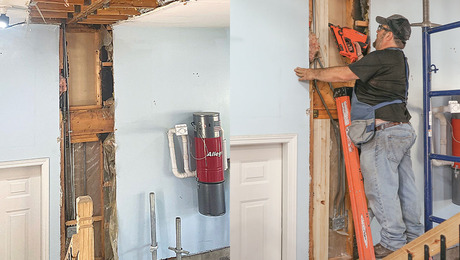On-demand water heater w/ radiant slab
I’m a big fan of stained and sealed concrete floors. As such, besides its other qualities, I like using radiant heating with them whenever possible. I have seen on-demand hot water systems used in conjunction with heated slabs and heard they achieved a high level of efficiency. However, I can’t seem to find too much on how to appropriately determine the system requirements; any comments/ suggestions would be great.















Replies
Glanced back at the older posts/threads....there yours sits...only posted....no answers.
My thoughts are that a boiler is an on demand heater that is designed for the purpose at hand...RFH. A domestic water heater, demand or otherwise has been designed to supply heating BTU's to a relatively small amount of thermal mass....RFH on the other hand constitutes a lot more total BTU demand.
I've seen water heaters used on RFH in smaller applications, and replaced as needed when worn out from over use. On the other hand I have seen boilers still going after 40 years.
Details, application, budget, longevity and payback are all considerations in your decision.
I personally try to go for the quality longhaul.............Iron Helix
Scout,
I was looking at that recently. I was thinking about a Seisco water heater for a RFH application. The way to size it is to do a heat loss calculation for your house and location. BTU demand is readily converted to KW. One KWH of electricity is 3400 BTU. The efficiency of an electric resistance heater is nearly 100.
A discussion I found very helpful happened here: http://forums.taunton.com/n/main.asp?qu=rfh+dilemma&find=Search&webtag=tp-breaktime&ctx=search&cl=632358&af=10000&o=relevance&be=0
In the end, I decided I will install a couple of 60 gal water heaters as the primary heat source. They cost about 60% of what the Seisco would cost, they are easier to replace when the time comes, they will need simpler control systems and they give me the possibility of later installing solar preheaters, which need storage capacity.
The Seisco would have given me much more precise temperature control and, with a Tekmar control/mixing valve system, much better anticipation of changes in demand and therefore, more limited temperature swings inside.
I can let you know how it works out in a couple of years.
I'd like to learn more about concrete staining. Any suggestions?
Ron
Edited 5/23/2004 8:03 am ET by RONBUDGELL
Edited 5/23/2004 8:09 am ET by RONBUDGELL
Here's the best info I've found re: concrete staining: http://www.ourcoolhouse.com/images/construction/acidetch.htm
A lot better than the manufacturer's instructions.
Thank you!
That's a great site.
Ron
scout67,
As mentioned, it is maximum BTU/H loss of the building from heat loss calculations. Wirsbo will did them along with the tubing layout for the house I'm building. Other outfits provide the service for free, also.
If you have passive solar gain, a person needs to size the heat source very closely to the max. BTU/H loss ('oversized' can cause problems) and zone/thermostat solargain/non-solar gain area.
Because of the way RFH provides heat, it is best to use constant circulation. Constant circulation and cast iron boilers (non-condensing) don't fit well but they can be made to work. There are some condensing boilers available, some have modulating heat output, also. Weil-McClean's "Ultra" boilers (modulating, condensing) are 98% efficient at low temperature supply (RFH water temps.) and 92% efficient at high temperature supply. The "Ultra" DHW storage tank has a 1/4 degee/hour heat loss. Weil-McClean guesses these boilers will last 15 to 20 years... time will tell if that is a conservative guess, or not.
Mike Krall